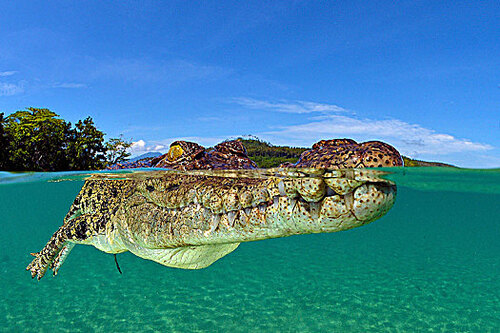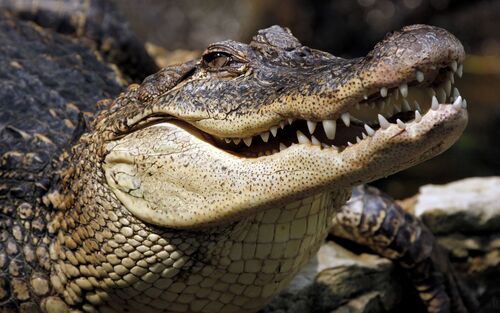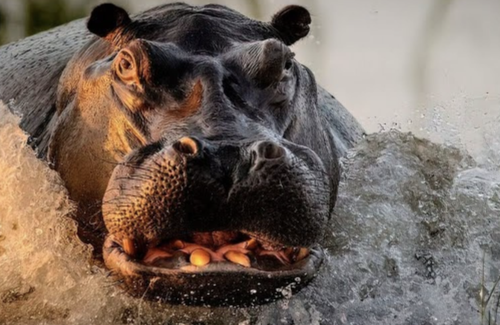In nature, the strength of bite force is one of the key characteristics of animal survival, especially for predators, a strong bite force means better hunting ability and the advantage of protecting themselves. Bite force is usually measured in Newtons (N), which represents the force exerted when the upper and lower teeth of an animal close together. So, which animals have the strongest bite force? The following will introduce several animals with the strongest bite force in order according to the size of their bite force.
Bite force: about 16,460 Newtons (N)
Saltwater crocodiles have one of the strongest bite forces on Earth today. With a bite force of up to 16,460N, they have the strongest bite force of any known animal. This tremendous bite force helps them easily capture and tear apart large prey, including buffalo, fish, and even small sharks. The saltwater crocodile's teeth are sharp and strong, combined with their powerful jaw muscles, making them the ultimate predator.
Survival Advantages :
The bite force helps them tear through the hard shells of prey, such as the shells of turtles or the bones of other animals.

Bite force: about 13,000 Newtons (N)
Nile crocodiles are close to saltwater crocodiles, and their bite force is also amazing, about 13,000N. Nile crocodiles are one of the largest predators in Africa, and are able to prey on a variety of large prey, such as zebras, wildebeests, and even hippopotamus calves. The strong bite force allows Nile crocodiles to easily tear the skin and flesh of their prey, and few other animals can escape its attack.
Survival Advantages :
The powerful bite force gives the Nile crocodile an advantage in hunting, allowing it to bite its prey and drag it into the water.

3. American Alligator
Bite force: about 9,452 Newtons (N)
The bite force of the American alligator is also very strong, close to 9,452N. They live in wetlands and swamps in the southeastern United States and feed on fish, mammals, reptiles, etc. The strong bite force helps them exert great pressure when catching prey, making it difficult for the prey to break free.
Survival Advantages :
The bite force allows alligators to easily capture and tear prey apart, and gives them an advantage over other crocodiles.
They are able to crush the hard bones of crustaceans or water birds.

Bite force: about 1,800 Newtons (N)
As the top predator in the ocean, the great white shark has an amazing bite force of about 1,800N. Although this is slightly smaller than that of a crocodile, the bite of the great white shark is very unique. Their teeth are as sharp as blades and can tear the flesh and bones of their prey. The great white shark mainly preys on marine mammals such as seals, sea lions, and even whale pups.
Survival Advantages :
The bite force of the great white shark combined with their sharp teeth allows them to quickly tear through the flesh of their prey.
The combination of bite force and attack speed makes them unrivaled hunters in the deep sea.

Bite force: about 1,825 Newtons (N)
Hippos are known for their huge size and ferocious character. Although they are mainly herbivores, their bite force is very strong, reaching 1,825N. The powerful jaws and teeth of hippos help them have an advantage in territorial fights or defense against predators. Their large teeth can be used to bite enemies and fight with their own kind.
Survival Advantages :
Bite force helps hippos defeat potential threats when fighting for territory and protecting their young.
They are able to tear apart intruders or predators with ease, and can even crush the bones of small crocodiles.

Bite force: about 1,500 Newtons (N)
Jaguars have the strongest bite force of all cats, with a bite force of up to 1,500N. This allows them to penetrate the skull or hard shell of their prey. Jaguars mainly prey on large mammals such as deer, wild boars, and even crocodiles. Their powerful bite force allows them to kill with one blow.
Survival Advantages :
The jaguar's powerful bite is able to penetrate bones and hit vital points when attacking its prey.
Their bite force allows them to hunt efficiently and quickly, without giving their prey a chance to react.

Bite force: about 1,200 Newtons (N)
Brown bears are large carnivores with a bite force of about 1,200 N. Although brown bears have a diverse diet that includes plants, fruits, and small animals, they rely on their strong bite force when hunting or fighting. Brown bears' teeth and jaw muscles enable them to easily tear the flesh of their prey and even break bones.
Survival Advantages :
Bite force helps brown bears gain the upper hand when fighting or hunting.
They can crush bones and break through the thick skin of their prey.

Bite force: about 700 Newtons (N)
Wolves are predators that excel at cooperative hunting. Although wolves' bite force is not as strong as that of crocodiles and big cats, their bite force is about 700N, which is enough to tear the skin and bones of prey. Wolves hunt large prey such as deer and reindeer through teamwork and use their bite force to tear flesh.
Survival Advantages :
The bite force of wolves allows them to wear down their prey through sustained attacks and then share its flesh.
Bite force combined with group strategy helps wolves capture larger prey.

Bite force: about 650 Newtons (N)
Lions, the top predators on the African grasslands, have a bite force of about 650N. Although their bite force is not as strong as that of jaguars, the cooperation of lion groups makes them efficient hunters. The bite force of lions is mainly used to deliver a fatal blow when the prey is trapped.
Survival Advantages :
Lions deliver fatal attacks by biting their prey's neck, using the force of their bite to quickly end the prey's life.
Bite force helps lions tear the flesh of their prey and share the spoils.

Bite force: about 250 Newtons (N)
Compared to other powerful predators, humans have a relatively weak bite force of only about 250 N. However, humans have a bite force that is sufficient to handle a variety of foods, such as nuts, meat, etc. Despite this, humans do not rely on strength for bite force, but use tools and intelligence to handle complex food problems.
Survival Advantages :
Although humans have a weaker bite force, technology and tools allow them to hunt and process a wider variety of food sources.
From the mighty saltwater crocodile to the relatively weak human, the bite force of different animals reflects their survival strategies and ecological position in nature.
animal tags: African-Lion Human Wolf Grizzly-Bear Jaguar Hippopotamus Great-White-Shark
We created this article in conjunction with AI technology, then made sure it was fact-checked and edited by a Animals Top editor.